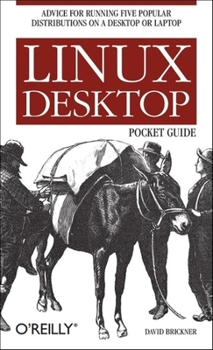Linux Desktop Pocket Guide: Advice for Running Five Popular Distributions on a Desktop or Laptop
Select Format
Select Condition 
Book Overview
While Mac OS X garners all the praise from pundits, and Windows XP attracts all the viruses, Linux is quietly being installed on millions of desktops every year. For programmers and system administrators, business users, and educators, desktop Linux is a breath of fresh air and a needed alternative to other operating systems. The Linux Desktop Pocket Guide is your introduction to using Linux on five of the most popular distributions: Fedora,...
Format:Paperback
Language:English
ISBN:059610104X
ISBN13:9780596101046
Release Date:November 2005
Publisher:O'Reilly Media
Length:195 Pages
Weight:0.40 lbs.
Dimensions:0.6" x 4.4" x 7.1"
Customer Reviews
5 ratings
Good small introduction to Popular Linux Distro's
Published by Thriftbooks.com User , 15 years ago
I wanted a small Up To Date inexpensive handbook for my customers to get an introduction to Linux without going to deep for beginners. I would recommend it for that purpose. Heavier books are needed for intermediate and advanced programmers and system admins.
Great product!
Published by Thriftbooks.com User , 17 years ago
The Linux Desktop Pocket Guide has helped me to to have a better understanding Linux.
Great resource
Published by Thriftbooks.com User , 18 years ago
This is basically a small format pocket reference to five of the most common desktop distributions of Linux. The distributions covered are Fedora, Gentoo, Mandriva, SUSE, and Ubuntu. The author covers the basics of navigating the GNOME and KDE desktop environments and the applications that come with each of the distributions. Deviating from the normal layout of such texts it is organized by the type of application instead of by the Linux distribution. As a result if you want to work with the web browser you go to that section where the author discuses the web browsers Firefox and Konquerer. These are the two that are included because each of the distributions has either one or the other. The section on how to add, remove, and update programs is particularly good as it discusses the various techniques including how to add a package that it not part of your distribution. Here the author not only discusses the various package managers included with the distribution but also how to go the long way around and work with rpms. This is not an extensive technical reference to any of the Linux distributions discussed but it is a good first resource for common questions and a good introduction to all of them. Linux Desktop Pocket Guide is recommended for the average Linux user and a must have guide for others who need to know the differences between various distribution.
Concise Guide to Linux Desktop Systems
Published by Thriftbooks.com User , 18 years ago
The Linux Desktop Pocket Guide is a valuable resource for new users to the Linux world. Almost everyone has heard of Linux and recognizes it as the "next big thing". However, many people are taken aback at the shear number of Linux distributions. The advantage of Windows is that there is only one company to go to and that provides some simplicity. With Linux, there is no one-stop shopping, and each distribution has different strengths and weaknesses. This book helps the novice user to navigate the most popular distributions to decide which will work best for them. The book compares Fedora, Gentoo, Mandriva, SUSE, and Ubuntu with a focus on their desktop environments. This book has some value for system administrators, particularly new ones, but will make the biggest impact to the casual home-user to the beginner power-user. It covers a wide range of desktop issues including Gnome/KDE support, application support, updating the OS, configuration for hardware support, and probably most usefully laptop support. Laptops have traditionally been less than friendly with laptops and this book helps navigate the big issues making Linux a viable option for laptops. It is a little thick as pocket guides go but that's more of a factor of the breadth of material covered. Like many of the O'Reilly books, it is concise and easy-to-read. It is accessible to the unsophisticated user and presents information in manageable chunks. For those looking to get a handle on Linux and making it work for them, this book is a great resource.
WHAT'S IN YOUR POCKET?
Published by Thriftbooks.com User , 18 years ago
Are you using one or more of the following Linux distributions: Fedora, Gentoo, Mandriva, Novell SUSE, and the desk-top-focused Debian derivative Ubuntu? If you are, then this book is for you! Author David Brickner, has written an outstanding mini guide to help you get the most out of your Linux experience. Brickner, begins with a valuable introduction to the Linux distributions. Then, he devotes a whole chapter to logging in. The author continues by looking GNOME. In addition, he discusses the KDI desktop. The author also presents at least two application programs for each program type. Then, the author shows you the basics of using each of the preferred package managers of each distribution. Next, he discusses how to configure some types of hardware with regards to Linux. Finally, he presents you with a grounding in the basics of what is needed and how the pieces fit together. After reading this excellent book, you'll learn all about the graphical programs and desktop environments that run on top of Linux. This book doesn't shy away from difficult topics in Linux; instead, it jumps right in and tells you what you need to know about laptop power management, configuring your graphics card, and setting up sound and networking.






